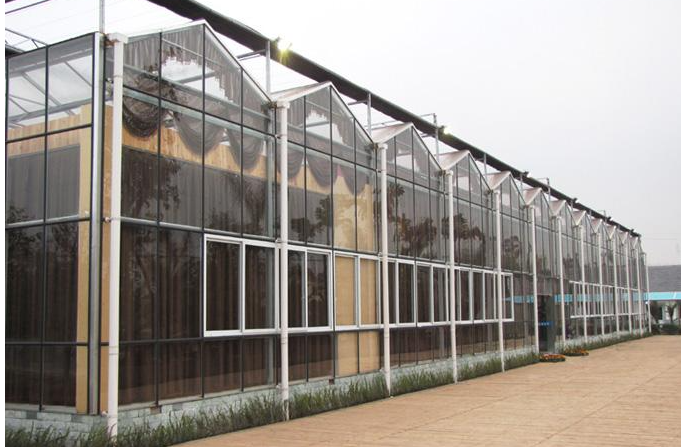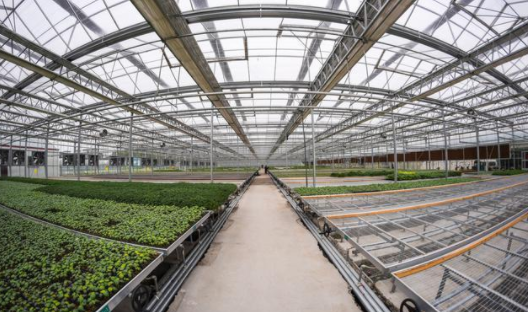
Heating and cooling of agricultural glass greenhouses
Glass greenhouse heating
Glass greenhouses in cold areas need to be heated, otherwise they cannot be produced. The length of the greenhouse heating time is different. In some areas, the heating time is about 5 to 6 months, and in some areas, it takes 3 to 5 months.

Hot water heating
The hot water heating system consists of three basic parts: a hot water boiler, heating pipes and heat dissipation equipment. Its working process is to use the boiler to heat the water, and then pressurize it by the water pump, and the hot water is supplied to the radiator in the greenhouse through the heating pipe. It is heated by a radiator to increase the temperature of the greenhouse, and the cooled hot water returns to the boiler to reheat and repeat the cycle. The hot water heating system operates stably and reliably, and is the most commonly used heating method for glass greenhouses.
Hot air heating
The hot air heating system is composed of a heat source, an air heat exchanger, a fan and an air supply duct. The working process is as follows: the heat provided by the heat source heats the air ventilator, and the fan is used to force part of the air in the greenhouse to flow through the air heat exchanger, so as to continuously circulate and heat the greenhouse. The heat source of the hot air heating system can be oil, gas, coal-burning device or electric heater, or it can be hot water or steam. Different heat sources have different installation forms of hot air heating equipment. The air heat exchanger of the steam, electric heating or hot water heating system is installed in the greenhouse and cooperates with the fan to directly provide hot air. Oil and gas heating devices are installed in the greenhouse, and the flue gas after combustion is discharged into the greenhouse. Coal-fired hot blast stoves are generally large in size and dirty in use, and are generally installed outside the greenhouse. In order to make the hot air evenly distributed in the greenhouse, a ventilator sends the hot air into the ventilation duct.

Electric heating
The more common electric heating method is to bury the geothermal wire in the ground to increase the ground temperature, and it is mainly used in the greenhouse to raise seedlings. Electricity is the cleanest and most convenient energy source, but electric energy is a secondary energy source, which is relatively expensive, so it can only be used as a temporary heating measure for a short period of time.
Greenhouse energy saving
The heat loss of the greenhouse is mainly through the following ways: conduction and heat dissipation through the glass envelope, which can account for 70% to 80% of the total heat dissipation loss; radiation to the sky; ventilation and heat dissipation; air penetration and heat dissipation; heat transfer in the ground. Greenhouse energy saving is to reduce the heat dissipation of the greenhouse, and the effective way is to install insulation screens, which can reduce the heat loss at night. Under the premise of satisfying crop lighting, it is best to install double-layer light-transmitting materials, which can reduce heat loss by 50%. It is also very effective to use cold-proof ditch and fill with thermal insulation materials to reduce heat transfer in the ground.
Glass greenhouse cooling
In summer, the temperature is high, and when the outdoor temperature is above 30°C, the temperature inside the greenhouse exceeds this 40°C. If only by ventilation, the temperature in the greenhouse is still above 35℃, normal production cannot be carried out in the greenhouse, and other cooling methods must be used to reduce the indoor temperature. The main greenhouse cooling methods used in daily production are:
Shade to cool down
It is to use opaque or low light transmittance materials to shade and reduce the light, prevent excess solar radiation from entering the greenhouse, not only to ensure the normal growth of crops, but also to reduce the temperature of the greenhouse. Due to the difference in shading materials and installation methods, the greenhouse temperature can generally be reduced by 3℃~10℃. Shading methods include indoor shading and outdoor shading. The indoor shading system is a support system made by pulling metal wires or plastic netting wires on the greenhouse framework, and installing the shading net on the supporting film line. Generally adopt electric control or manual control. The outdoor shading system is to install a shading framework outside the greenhouse framework, and install the shading net on the framework. The shading net can be driven by a curtain pulling mechanism or a film rolling mechanism, and it can be opened and closed freely. The sunshade net is installed outdoors and has a good cooling effect. It can directly block the solar energy outside the greenhouse. Various types of sunshade nets can be used.
Evaporation cooling
Evaporative cooling is to use the unsaturation of air and the latent heat of evaporation of water to cool down. When the moisture in the air is not saturated, the moisture will evaporate and become water vapor into the air. While the water evaporates, it absorbs the heat in the air, reduces the air temperature and increases the air humidity. In the process of evaporative cooling, the air flow inside and outside the greenhouse must be ensured, the high temperature and high humidity gas in the greenhouse must be discharged out of the greenhouse, and fresh air must be added, so forced ventilation must be adopted. The method of cooling by evaporation is wet curtain-fan cooling and spray cooling.
Roof spray cooling system
It sprays water evenly on the roof of the glass greenhouse to lower the temperature of the greenhouse. When water flows on the roof of the glass greenhouse, the water exchanges heat with the glass of the greenhouse roof to take away the heat in the greenhouse. In addition, when the thickness of the water film is greater than 0.2 mm, all the energy of solar radiation is absorbed and carried by the water film. Go, this point is equivalent to shade.
Tags:anti-reflective glass diffuse glass agricultural greenhouses glass greenhouse venlo greenhouse AR glass greenhouses glass agricultural glass horticultural glass #greenhouseglass #Antireflectiveglass #Diffusetemperedglass #Ultrawhitefloatglass #agriculturalgreenhouseglass #diffuseglass #horticulturalglass #Tomatogreenhouse #Coloredpeppergreenhouse #Lettucegreenhouse #Agriculturalgreenhouse #ARglass #venlogreenhouse #greenhouseglass #Antireflectiveglass #Diffusetemperedglass #Ultrawhitefloatglass #agriculturalgreenhouseglass #diffuseglass #horticulturalglass #Tomatogreenhouse #Coloredpeppergreenhouse #Lettucegreenhouse #Agriculturalgreenhouse #ARglass #venlogreenhouse #GlassManufacturer #invernadero #ArchitecturalGlass #ClearFloatGlass #FloatGlass
Previous:How to ventilate the glass greenhouse
Next:The construction of venlo glass greenhouse should pay attention to these points



















